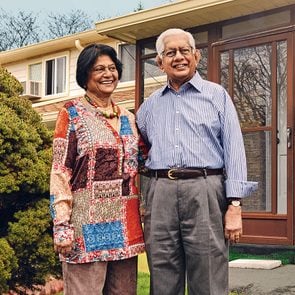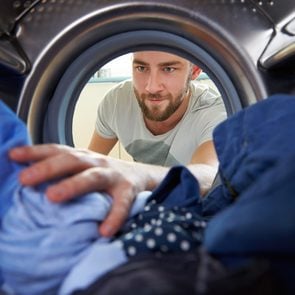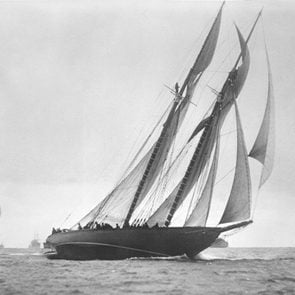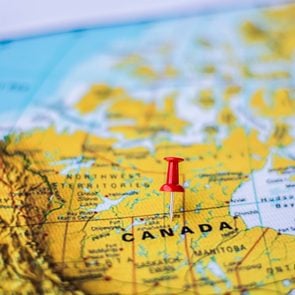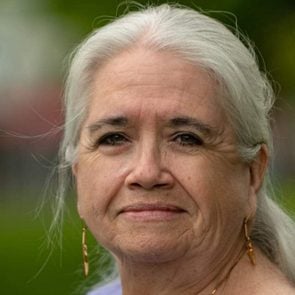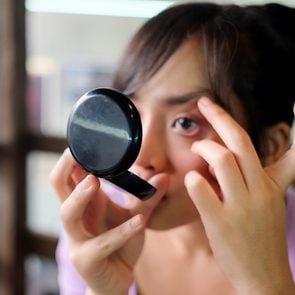Another day, another TikTok hack to help make our lives a little easier. Thanks to these viral videos, we’ve learned everything from how to make powdered sugar to hacks for cleaning your wooden spoons. Today, we found a little something to help make peeling potatoes quick and easy.
A Clever Hack For Peeling Potatoes
Gone are the days when you’d spend tons of time peeling potatoes by the bagful. Sure, you can leave the skins on your potatoes for tons of recipes, but sometimes there’s just no way of getting around it… Like when you want to enjoy a big batch of buttermilk smashed potatoes.
TikTok user @thatdudecancook showed us a potato peeling hack to get this job done quickly and efficiently—and it’s quite simple. Just stick a fork in the potato, peel the long sides using a peeler, pull the fork out and finish peeling the top and bottom of the spud. That’s it!
@thatdudecancookBest potato hack ever #potato #kitchenhacks #cookingtips #cooking #learnontiktok♬ original sound – Sonny Hurrell
Does this hack really work?
This meal-prep shortcut seems to work best with medium and larger sized potatoes, because you take longer strokes with the peeler. Of course, you still need the help of an ordinary potato peeler, and you’ll have to work your way around the bumpy parts of the potato, but the time spent on the project overall is substantially reduced. Don’t forget that you have to stick the fork pretty deep into your potato to keep it steady while peeling—otherwise it will roll away.
Now that you’ve got this trick for peeling potatoes under your belt, check out 12 cooking hacks that’ll save you time, money and effort.
In 2007, as part of her work at the Council on Aging in Kingston, Ontario, Christine McMillan began interviewing seniors in the city about their most pressing needs. A couple years into that project, McMillan, who was 79 years old at the time, connected with people living in Bowling Green 2, an unassuming grey mid-rise that’s part of a complex of buildings across the street from the Kingston Centre mall. It isn’t a bad place to grow old: its apartments are affordable and within walking distance of grocery stores, pharmacies and banks.
Despite those conveniences, however, the 12 residents McMillan spoke to confirmed an unaddressed problem she’d already identified among this demographic: crushing loneliness. Most of them were widows and described sitting in their apartments all day, watching TV and napping—and subsisting on tea, toast and cereal because they lacked the motivation to cook a proper meal for themselves. They dreaded having to go into long-term care but couldn’t afford to move to a retirement home.
“What they said really bothered me,” says McMillan. But it also underlined a question she’d been asking herself since she began the research: why couldn’t the activities and meals that happen in the common room of a retirement home exist in the common spaces of a private apartment building?
McMillan and her team, who named their concept Oasis, got Bowling Green 2’s landlord to let the group use the common room and to convert an unused space into a coffee lounge. Then, in 2010, with funding from the federal government, they hired full-time staffers to run the program, which included group exercise classes and activities like art lessons and Wii bowling. (More funding followed from the City of Kingston, the United Way and local health networks run by the province.) Meanwhile, Oasis partnered with St. Lawrence College, whose culinary students created healthy meals for participants to eat in the common room for a small fee.
“I’ll never forget our first meeting—the residents were so excited,” says McMillan, adding that she was particularly touched by one woman who shared how isolated she’d been. That woman told the group that when she’d opened her door to attend Oasis, she chatted with the woman across the hall for the first time. Both of them, they realized, had been sitting alone in their apartments all winter, not knowing a potential friend was so near.
Within the first year, the program almost doubled in size. Participants lined up down the hall to wait for the coffee lounge to open in the mornings, and the collective dinners often stretched to two or three hours long as people kept chatting.
Seventy-seven-year-old Elaine Watier, who moved into the building and joined Oasis in 2017, immediately reaped the benefits of the program, learning to play bridge and starting a craft group that makes projects for local charities and hospitals. “It’s given me a sense of worth,” she says. “And I’m never lonely.”
In 2018, Oasis attracted the attention of researchers at Queen’s University, who received grants to temporarily expand the concept to six more buildings in southern Ontario—including in London and Hamilton. “My co-investigator, Vincent DePaul, and I saw this as an ideal program to help think about how to support older adults at home,” explains Catherine Donnelly, director of the school’s Health Services and Policy Research Institute. After analyzing Oasis, she reported that the program had led to fewer falls, less inactivity, better nutrition and, of course, an increased sense of community.
While Donnelly and her team try to put together funding to keep the Oasis programs going long-term, they continue, with some adjustments, during COVID-19. McMillan, for her part, has partnered with the University Health Network to create an Oasis in the Toronto apartment building where she moved a few years ago. She thinks the idea deserves to keep growing. “It’s cheap and it addresses all the issues of aging,” she says. “Apartment owners love it, seniors love it, and their families love it.”
Next, meet the four Ontario women who found their own alternative to retirement living.
There’s a good reason people are opting to remove personal information from Google: A simple Google search can potentially give someone more information about you than you’d like. A stalker, an employer, or a nosy coworker can often easily find information about where you live, your family’s names, and more. In some cases, confidential information like your credit card details, medical history, and signature are also available. At best, this can be embarrassing. At worst, it raises concerns about online security, including identity theft.
It can be tempting to try to disappear completely from the Internet. But that takes a lot of legwork, especially when it comes to data brokers, and there is still likely to be a trace of you online. And while Google collects a lot of information about you—yes, even if you do an anonymous search without tracking, use Google Incognito mode, delete your Google activity, and say no to cookies—it doesn’t include that data in its search results. So if you’re concerned about the personal info that’s appearing in a Google search, you’re better off taking it up with the source: Google.
The search giant is making a show of its efforts to protect our privacy these days. Google announced in April 2022 that it has updated its policies to allow people to request the removal of their sensitive and personally identifiable information from search results. This adds to existing policies allowing people to request the removal of highly personal information that could cause them direct harm. So read on to find out the easiest way to remove personal information from Google. Then keep improving your digital security by learning how to tell if your phone has been hacked.
What information can I remove from Google?
Until its most recent privacy policy update, Google would only remove search results featuring highly personal information that could cause direct harm—such as explicit images and videos or fake pornography—if a user requested it. Now, the powers that be will consider general personal and sensitive information for those who wish to protect their privacy. This could include your:
- Home address
- Telephone number
- Email address
- Work address
- Credit card or bank details
- Medical history
- Confidential log-in details
If you think having this kind of information out there isn’t important, perhaps it’s time you learned what hackers can do with your phone number.
First of all, should you remove personal information from Google?
It’s definitely a personal choice, and your specific situation should inform your decision. “Some people are fortunate to have common names, so when they do Google themselves, they may be buried in the search results,” says Andrew Selepak, a social media professor at the University of Florida. “But people with more unique names may appear in the first few Google search results.”
Before you go on a deleting spree, first take a look at what actually comes up when you Google yourself. To do this, open an incognito window by going to the Chrome browser menu and selecting “File” and “New Incognito Window.” Then type your name into the search box surrounded by quotes. For example, if your name is Joe Jones, you would search “Joe Jones.” Be sure to Google your first and last name, and then your first, middle, and last name. Take note of what pops up on the searches. These will be what you want to focus on removing, if they seem problematic.
Remove personal information from Google for the right reasons
If you’re trying to delete yourself from Google searches so that corporations won’t have your information, you’re going in the wrong direction. Most of the information that companies get about you isn’t gathered from a Google search. This information is typically collected from your social media usage or your online shopping habits, and other data-gathering techniques.
Once the information is in hand, it’s sold from company to company. So even if you decide to wipe yourself from Google searches, there will likely still be plenty of information about you floating around. Removing yourself from Google search results will only help prevent future employers, potential stalkers, and nosy people from easily finding your personal information.
OK, so you’ve made an informed decision to remove personal information from Google. Let’s dive in.
How do I remove all my personal information from Google?
To remove yourself from searches, your first—and maybe most obvious—step is to delete your social media accounts, or at least change the information from your real name to a fake name. “Google can’t show information that doesn’t exist,” says Dave Nilsson, a digital marketing expert with The Converted Click. “If a website removes your credentials, Google will re-crawl, and your information will no longer appear in search results.”
Don’t forget to delete or change old accounts that you haven’t used in years, like on MySpace or Reddit. Googling yourself should turn up any old accounts you may not remember.
Want to keep your accounts? Set your Facebook, Instagram, and other social media accounts to “private,” which prevents Google from showing your pictures in search results too, notes Nilsson. Note, however, that it can take weeks for deleted content to stop showing in search results. For anything that still remains, you can petition Google.
Here’s how to remove personal information from Google via the search engine’s request form:
- Use this form to request that Google either hide the search results or delete the content.
- Depending on which option you pick, you’ll be asked for more information, such as whether you are requesting the content be removed from Google search results and a website or just the search results, and whether or not you’ve contacted the website owner.
- From there, specify what type of personal information is showing up in the Google Search.
- Check the box indicating the content is live (use this form instead if the content has already been removed but is still showing up).
- Google will ask whether the request pertains to doxxing, which the company defines as “contact information being shared with malicious, threatening, or harassing intent.” However you reply, you’ll need to provide links to the offending website, search results, or picture and give your name, country of residence, and email address.
- Toward the end of the form, you have the opportunity to share a list of relevant search terms, such as your full name, nicknames, and maiden name. Google will also ask you to share supplementary details before signing and submitting the removal request.
How long does it take for Google to remove personal information?
Google will send you an email right after your submission to acknowledge it has received your request. The company may contact you if your request does not provide enough details, such as the URLs of the offending content. You will then get a notification of any action taken, such as whether the URLs will be removed from all searches or just those containing your name or other provided identifiers.
If the case does not meet the requirements for removal, you’ll receive a brief explanation as to why and be given a chance to supply additional materials to support your case and resubmit your claim. Unfortunately, Google has not specified how long it is likely to take for decisions to be made.
Will this remove my personal information from the Internet?
Not exactly. Google only has power over what appears in its search results—not what appears on the Internet as a whole. Plus, there’s no guarantee that the search engine will agree to remove the results containing your information, or that it will remove your info from all searches instead of just those containing your name and aliases.
Google has also stated that when it receives removal requests, it will evaluate all content on the webpage to ensure that it’s not limiting the availability of other information that is broadly useful, like information in news articles. It also won’t remove results when the content appears as part of the public record on government or official websites.
And finally, just because something is removed from a Google search does not mean it’s been removed from the Internet. The information could still be found via a different search engine or if direct links to the content are posted on social media, for example. You would need to contact the owner of the website directly if you want your information removed from the page. You can typically find contact information on a site’s About Us or Contact pages. If that garners no helpful information, go to WhoIs.com to get the contact information.
Can I push down results that I can’t remove?
If you have an embarrassing mug shot or other issue that shows up on a Google search and you can’t seem to get rid of it—even after contacting Google or the site owner—you can at least force whatever you don’t like to show up farther down in the results, according to tech expert Caleb Riutta of Dusk Digital.
You do this by flooding Google with other pages that have your name. New social media accounts on different platforms and a new personal blog can all push the embarrassing information back in the search results. “When you update your information in as many places as you can online, Google will start showing this first, as it is up to date and relevant,” Riutta explains.
Of course, this counteracts the idea of wiping yourself from Google, but at least it will make a search present you in a better light.
What else can I do to remove my personal information from the Internet?
Besides removing your personal information from Google searches, there are other steps you can take to delete more of your digital footprint. Let’s take a quick look.
Contact data-collection sites and data-broker services
While Googling yourself, you probably found sites that say things like, “We’ve found the phone number for Joe Jones” or “Click here to get the credit score for Joe Jones.” These sites are data-collection and data-broker sites. You can use them to access information about someone—including their address, phone number, and family members’ names—for a fee.
Getting your data removed from these sites is totally doable, but it can be a hassle, as each one has a different process. You’ll need to follow the instructions on each individual site, or you can use services like DeleteMe, which will do the work for you, for a fee.
Keep in mind: There’s a chance your info could end up on these sites again in the future. One way to limit the amount of data you inadvertently share is to use good passwords and two-factor authentication, and possibly a password manager that’ll help you keep track of them without relying on common password lists. Another tip from cybersecurity experts: Turn off location tracking on your iPhone and in any apps you use to prevent them from collecting and selling your data.
Here are the weakest passwords you could possibly choose.
Delete website comments
Believe it or not, simple comments on website articles can come up in a search too. If you can’t log on to the site and delete the comment yourself, you’ll need to contact the owners and ask them to manually remove the comment. Remember, though, that website owners don’t have to delete comments, and probably won’t, but it’s worth a shot.
“The Internet is still the Wild West, with little government regulation, and it is very difficult to have anything taken down, even if it makes you look bad or is embarrassing,” Selepak says. “Your only recourse is the kindness of strangers, and sadly, we don’t live in a very kind time.”
Hide your home on Google Maps
A Google search of your address will bring up a photo of your home on Google Maps. If that makes you uncomfortable, you can get Google to blur out your house quite easily.
Go to Google Maps, search for your address, and click on the photo of your home. The image will enlarge, and you’ll see a black box appear with your address. Click on the menu inside the box and choose “Report a Problem.” Fill out the form that comes up on-screen and submit it when you’re done. One important note: Google can’t undo this change.
Practice good digital hygiene
Good digital hygiene goes beyond—and may be more important than—Google search results. So as you take stock of the personal information available on Google, consider how you might address security issues that put you at risk for cybersecurity threats such as phishing attacks, spyware, and identity theft.
Next, find out why you need to stop commenting on those viral Facebook memes.
Your clothes have that lovely detergent scent fresh out of the laundry, so you feel confident putting those clean undies on. But hold on—those fabrics might not be as clean as you thought, and your cleaning methods are to blame.
The average pair of clean underwear still contains about 0.1 grams of feces and could hold up to 10 grams, according to a Journal of Infection study led by Charles Gerba, PhD, microbiology professor at the University of Arizona.
If you aren’t already washing your underwear in hot water, it might be time to start. Anything below a hot cycle of 60° Celsius won’t do much against bacteria, says Dr. Gerba. Cold water is “designed to get clothing clean but not eliminate microorganisms,” he says. Using an activated oxygen bleach detergent like OxiClean or Clorox 2 can sanitize your clothes, even if you don’t want to throw your delicates in hot water, says Dr. Gerba.
Without hot water and bleach, bacteria from your underwear can spread to other clothes in the wash too. Unloading that “clean” laundry into the dryer gets bacteria on your hands, which means you could spread it to other fabrics or even up your risk of infection by spreading the bacteria to everything you touch. Keep your underwear separate from the rest of your laundry to avoid spreading the germs, suggests Dr. Gerba.
Even those best practices might not get rid of bacteria completely, though, because those germs don’t just disappear after your clothes have been in the laundry. Some of that bacteria—including E. coli—stick around in the machine after the cycle is over, says Dr. Gerba. Washing your underwear last will keep that away from your other loads, but you should clean the machine itself by running an empty cycle after every underwear load. “Give the washing machine a mouth wash by running bleach through it and killing bacteria left,” he says.
Next, check out 16 genius hacks that make laundry day less of a hassle.
Burning out the clutch and stalling as you roll back on a hill used to be part of learning how to drive in North America. But these days, fewer and fewer people are driving cars with stick shifts in Canada and the United States. In fact, Edmunds.com reports that stick shifts made up just two per cent of all vehicles sold in the U.S. in 2018.
“For automakers, it will be simpler when the manual dies,” Ivan Drury, a senior analyst for Edmunds.com, told the Chicago Tribune. “It’s kind of a hassle for them to offer both, same with dealers. Given market forces, it’s going to go away.”
Contrast that with Europe, where almost everyone learns to drive a stick shift, and manual transmissions account for roughly 80 per cent of vehicles on the road. Here are some of the reasons why:
Why more North Americans drive automatics
Automatics are much more utilitarian cars that get people from point A to point B, says Lauren Fix, the Car Coach. As such, North Americans are much more likely to be doing several things at once when they’re driving. That’s not the case in the rest of the world. “Americans eat while they drive and they multitask while they drive,” Fix says. “Europeans do not.” (Keep in mind, eating while you drive is definitely one of the things you’re doing in your car that you shouldn’t.)
Europeans are also more likely to own higher-end cars. You would never see a manual Porsche Cayenne in North America, but you will in Europe.
Why Europeans like manual transmissions
The preference starts early. In Europe, 15- and 16-year-olds learn to drive on Microcars with stick shifts. Fix says she doesn’t know anyone in Europe who doesn’t know how to drive one. In addition, driving a car with manual transmission forces people to be more engaged with their car and what’s going on around them.
“They pay attention to the road much more so than we do here,” Fix says. “I have been all over Europe and nobody’s on the phone while driving. Not even on speakerphone. They just don’t. That’s just not part of their culture.”
That’s not to say that the Europeans don’t have fun on the road. Germany is also home to the Autobahn, where there’s no speed limit and drivers are often going well over 160 kph. Europeans also prefer cars with manual transmissions because they use less fuel—an important consideration when people in Norway pay an average of $2.07 CAD for a litre of gas, according to Sixt.com.
Who still drives manual cars in North America?
The idea that cars with manual transmissions are less expensive than automatic cars isn’t really true, according to Edmunds.com.
A few brands do still make stick shift models, including Volkswagen, Mini, and Miata, Fix says. Porsche has also gone back to making cars with manual transmission after switching to a PDK, or a paddle-shift, Fix says. Sports cars known for their loyal fans such as Mustangs, Corvettes, and Camaros are also still made with stick shifts. “You find them to be manual because it is a joy and a thrill to drive them,” Fix says.
Whether you’re looking for an automatic or manual transmission, here’s the best time to buy a new car.

I met Opal in the winter of 1981. She had arrived on a fierce February night. An unexpected guest on an unwanted vacation. Opal had been floundering in the Bay of Fundy. Mechanical failures. Her engine had quit. High winds and rough waters battered her. Blackness of the night surrounded her. Tug rescue was dangerous. Choppy seas made connection with Opal almost impossible. Almost. After several desperate attempts a line was finally secured. The tug had saved her from an unknown fate. Opal was coaxed towards Saint John harbour for repairs. But the Fundy waves would not let her be. They relentlessly pounded her side. With the harbour’s lights in sight the tow line snapped under the tension. Frantic efforts were made to secure yet another line. They failed. Strong winds and choppy seas reclaimed control. The powerful waves forced her towards the rural Red Head shore. Towards our cove. What a surprise to see a 6,000-ton cargo tanker, near the size of a football field, had been abandoned on the beach overnight—a spectacular castoff from the unsparing sea.

Uncertain Future
Braving the salty winter air, visitors flocked to see Opal. Dwarfed by her sheer size, they resembled the foraging seagulls as they milled about the seaweed-shrouded rocks at low tide. Over time, interest began to ebb until it was just the locals that gathered around her, an impromptu meeting place. Discussions about what would be required to set her free became the favourite topic. But releasing Opal back into the wild was not an easy task. She was brought in on a stormy high tide. Opal learned the hard way that our Bay of Fundy boasts the highest tides in the world. She was now at the mercy of the sun and the moon which controlled them. Opal needed the highest of high tides to launch. There was no difficulty in calculating when those would occur, but there’s a mere six hours between the high and low tides. It would be a race against the clock. The weather and the fog were additional wildcards. Opal’s mechanical failures prohibited her from launching off the beach on her own, even in the best conditions. She would have to be engineered off. Diesel oil was pumped from her fuel tanks to help lighten her weight. But there was another concern to address before she could shove off—had her hull been damaged by her grounding? If it was intact she would be ready to go. If it was irreparable, her life would end on this beach, dismantled for scrap. It was an unthinkable end for our new friend. Could she be moved? Opal waited day after day, for weeks, then months for that answer. Red Head waited too, worrying, commiserating and speculating over the future of our stranded traveller.

Spring Launch
But on a clear day in early May, bulldozers were on the beach digging channels in the sand at Opal’s sides while the tide was still low. Was today the day? Three tug boats stoically waited like sentinels in the open waters. Tow cables were attached and we watched with both anticipation and trepidation as the ocean made its scheduled appearance. The tides were extremely high and the weather was good. Timing was everything. The water surrounded Opal and pushed past her over the rocks to crash on the sandy shore. As the water level rose she did too. The tug boats seized their opportunity. Opal shifted, then moved. Freed at last from her long confinement. We cheered. We high-fived. We were happy for her. But in a small way we were sad to see her go. She belonged to us, our community, our family. We watched as she made her way out to the open water, off to the shipyard and then to faraway lands.
Opal‘s Final Days
After Opal’s engine repairs she had a few more good years of travel. I learned that in 1988 she was arrested in Karachi for reasons I could not determine. Opal experienced another blow in ’89 from a devastating fire. She was later abandoned. Sadly, in 1993 she went to her watery grave at her anchorage. Opal is gone but I will always remember our amazing, unexpected guest.
Next, take a look back at Canada’s most famous shipwrecks.
Car maintenance is important, but it’s often overlooked unless you write down when certain tasks need to get done. This hint will help!
If you have a vehicle with a large, exposed air filter cover that’s flat, like the one on my truck, you can use a chalk marker to write important information about when you last changed the oil, air filter, spark plug, etc.
The marker I used is the kind that requires ammonia-based cleaner (such as Windex) to clean it off, so any water that splashes into the engine compartment won’t erase it. If you’re like me and always forget to write this information in the car manual, this tip will remind you every time you pop the hood.
Next, find out how to pour motor oil—without making a mess.

Inspiring Women in Canadian History
Marie-Josèphe Angélique (1710-1734)
In 1725, a French merchant forced Marie-Josèphe Angélique, a Portugal-born Black woman, to work in Montreal as a domestic slave. When 29-year-old Angélique overheard the merchant’s widow planning to sell her to another slave owner after nine years of having her demands for freedom denied, she fled the house where she was being kept, reportedly setting fire to her bed. That same evening, the south of rue St-Paul caught on fire, spreading rapidly, thanks to strong winds. In less than three hours, 46 homes and buildings burned down, but no one died. The resulting trial lasted six weeks, during which Angélique adamantly denied all accusations from the 22 people who testified against her. On June 4, 1734, a judge found Angélique guilty and sentenced her to death. Whether or not Angélique truly caused the fire, her trial and death symbolize Canada’s part in the slave trade. Today, Angélique is remembered as the first Black person in North America to challenge her slave status.
Shawnadithit (c.1800–1829)
Shawnadithit was the last member of the Beothuk, Algonquian peoples who lived in the south and northeast coasts of Newfoundland and numbered approximately 500 to 1,000 members when they first came into contact with Europeans in the 1500s. By the 1800s, when Shawnadithit was a few years old, that number was far less. European colonizers from England and France had settled for over a century, bringing disease and sowing conflict. While living with a group of Europeans who captured her, Shawnadithit would go on to witness the decline and eventual extinction of her people. In 1828, when she was in her mid to late 20s, the Beothuk Institution in St. John’s commissioned Shawnadithit to document the languages and customs of her people. She did so through telling stories and sketching maps, tools and people. Her documentation work is responsible for most of what we know of Beothuk culture today.
Mary Ann Shadd Cary (1823–1893)
Mary Ann Shadd Cary was the first Black woman newspaper editor and publisher in North America. In 1853, she founded the Provincial Freeman, a weekly newspaper published in Toronto, Windsor and Chatham that advocated for equality and literacy for Black people in Canada and the United States. She also wrote about Black people thriving in freedom to promote emigration to Canada. In 1851, she established a racially-integrated school for Black refugees in Windsor. After moving back to the U.S. in 1861 after 10 years in Canada, she became one of the first Black women to earn a law degree in the U.S. In 1994, the Government of Canada named Shadd a Person of National Historic Significance, recognizing her publishing accomplishments and her community work.
Here are 10 historical landmarks every Canadian should visit.
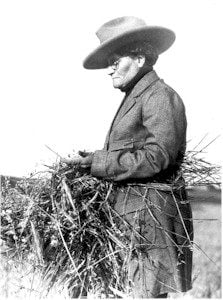
Ella Cora Hind (1861–1942)
Ella Cora Hind was the first woman journalist in Western Canada. After being denied a reporter position at the Manitoba Free Press in 1882 for being a woman, she became a public stenographer and kept a close eye on prairie farming developments. Despite being denied a full-time position, she frequently submitted articles on farming to the Free Press, and her farm upbringing made it easy for her to speak with agricultural workers. Soon, she became popular for her grain expertise. Her opinion was valued so much that it would often influence Winnipeg Grain Exchange prices. Finally, she was hired as Manitoba Free Press’ agricultural editor, and also founded the Canadian Women’s Press Club’s Winnipeg branch in the mid-1900s. She fought for women’s rights and helped lead the suffragist movement that witnessed Manitoba grant women the right to vote and hold office. Hind received an honourary LL.D from the University of Manitoba in 1935.

Alice Wilson (1881–1964)
In 1909, Alice Wilson became the first woman geologist in Canada, and in 1938, she became the first woman Fellow of the Royal Society of Canada, a council of distinguished scientists, artists and scholars. At age 28, she worked as a museum assistant for the Geological Survey of Canada cataloguing and labelling collections at the Victoria Memorial Museum. However, the survey banned her from conducting field studies in remote locations with male colleagues—a policy that didn’t change until 1970—so she made shorter solo trips to the Ottawa-St. Lawrence Valley, studying fossils and rocks on foot and by bicycle. She later bought her own car when the survey denied her one—even though it was common practice for male colleagues. When Wilson retired in 1946, the survey had to hire five new people to do the work she did alone. She received an honourary degree from Carleton University in 1960, where she had lectured on paleontology from 1948-1958.
Here are the best places to see dinosaur fossils across Canada.
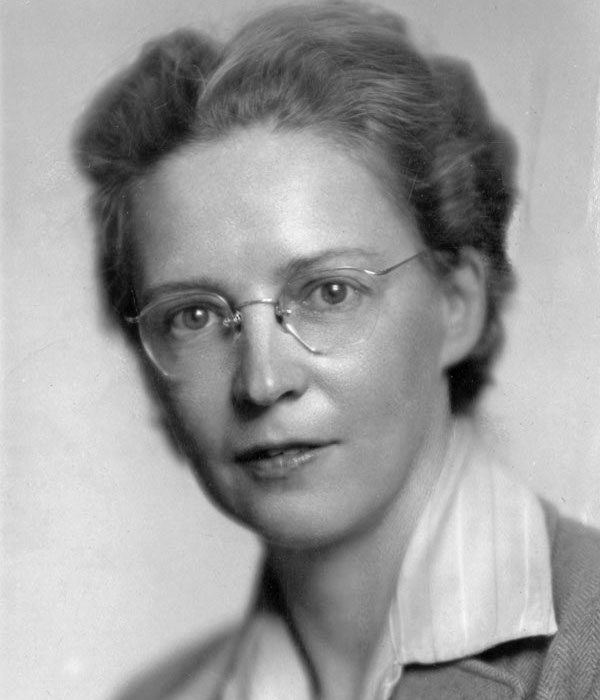
Elsie MacGill (1905–1980)
In the early 1920s, Elsie MacGill was the first Canadian woman to earn a degree in electrical engineering, the first woman in North America to earn a master’s degree in aeronautical engineering, and the first Canadian woman to become a practicing engineer. During the Second World War, she designed the Maple Leaf II Trainer: one of the first aircraft to be designed by a woman, it was a biplane trainer that MacGill re-engineered to be faster than its predecessor. After the war, she worked in aeronautical consulting and was a women’s rights activist. She held leadership roles at the Canadian Federation of Business and Professional Women’s Clubs from 1956 to 1964. Three years later, she worked at the Royal Commission on the Status of Women, where she successfully fought for their 167 recommendations to be implemented by the federal government.
Read the incredible story of Canada’s first commercial flight.
Jean Lumb (1919–2002)
Jean Lumb played a pivotal role in reforming Canada’s discriminatory immigration laws. In 1959, at age 40, she opened her first Cantonese eatery in Toronto, where she would host discussions on discriminatory legislation with both politicians and activists. Those gathered would discuss older legislation, such as the Chinese head tax, which was enacted to discourage immigration and charged $50-$500 per family member to enter Canada, and the more recent, but equally-prejudiced, Chinese Immigration Act, which rendered the head tax moot by denying entry to most Chinese immigration applicants. The latter was repealed in 1947, but remaining restrictions made it nearly impossible for Chinese immigrant families to reunite in Canada. That changed in 1957 when Lumb and 39 others—all men—formed a delegation to successfully abolish all immigration restrictions based on race, and instead establish criteria based on skills and education. Lumb was also the first Chinese-Canadian woman to be inducted into the Order of Canada.
Can you name these famous Canadian heroes?

Kenojuak Ashevak (1927–2013)
As one of Canada’s most acclaimed graphic artists, Kenojuak Ashevak travelled the world to showcase her Inuit art throughout the 1980s and early 2000s. In the 1950s, she became the first woman to collaborate with West Baffin Co-operative, a well-known printmaking shop at Cape Dorset focused on Inuit graphic art. Following her debut there, Ashevak received near-instant recognition for her simple yet whimsical interpretations of the natural world. Her most famous work, The Enchanted Owl, which uses energetic linework, was featured on a Canada Post stamp in 1970. In 1993, Ashevak was commissioned to create a piece she called Nunavut – Our Land to commemorate the many milestones leading to the establishment of the territory. It’s a lithograph depicting Arctic life in Canada and is on display in the Canadian Museum of History. She was a Companion in the Order of Canada and is the first Inuit artist inducted into Canada’s Walk of Fame.
Here are more mind-blowing artefacts you’ll find in Canadian museums.
Dr. Lillian Dyck (1945–Present)
In 1981, Dr. Lillian Dyck became one of the first Indigenous women in Canada to receive a doctorate in the sciences. Dyck went on to work as a neuropsychiatry professor at the University of Saskatchewan from 1981-2005, eventually becoming an associate dean. Dyck is also the first Indigenous and Chinese-Canadian woman appointed to the federal Senate. She retired in 2020 after years of advocating for the rights of Indigenous peoples, Chinese-Canadians, and women. She was a leader in the fight for the 2015 inquiry into missing and murdered Indigenous women and girls, challenging the RCMP’s questionable statistics and pushing for harsher sentences for people who harm Indigenous women. In 2019, she received the YWCA Women of Distinction Lifetime Achievement Award both for her leadership in the sciences and for serving as a role model within Indigenous communities.
These podcasts for women are worth adding to your playlist.
Shirley Firth (1953–2013) and Sharon Firth (1953–Present)
Twins Shirley and Sharon Firth were among the first Indigenous athletes to represent Canada at the Olympics. They were members of the first Canadian women’s cross-country ski team and competed in four Winter Olympic Games from 1972-1984. Between the two, they won 79 medals at the national championships. After retiring from skiing, Sharon returned to the Northwest Territories in the mid-’80s and re-established the defunct Territorial Experimental Ski Training Program, the same Indigenous youth-targeted initiative that introduced her and Shirley to competitive skiing. Shirley moved to Paris, where she taught about Dene and Inuit cultures in numerous European institutions. In 2015, they were inducted into the Canada Sports Hall of Fame.
Next, read the incredible stories of 20 more unsung Canadian heroes.
Martin Taylor, a 42-year-old software engineer by day, plays lead guitar in a local band in Aberdeen, Scotland. In September 2016, while helping his bandmates unload heavy equipment before a gig, he felt suddenly light-headed. He shrugged it off, but the sensation worsened over the next few weeks. Taylor felt increasingly breathless and tired that autumn. Meanwhile, his appetite dwindled. And though he’d try to get a good sleep, he’d frequently wake up during the night feeling light-headed.
Then one evening in November, while Taylor was setting up band equipment at a wedding, he had a bad dizzy spell. “I almost passed out,” he recalls. One of his bandmates grabbed him before he dropped to the ground. Finally, he made an appointment with a GP at a nearby medical practice.
The doctor thought Taylor had a minor chest infection that would pass, but Taylor only felt more wretched as the days went by. He returned and saw a different GP, who ordered a chest X-ray to look for any problems like bronchitis, pneumonia or even a tumour. The report was normal.
Gasping For Breath
By December, Taylor was too sick to go to work or band gigs. He slept around the clock and felt breathless at the slightest effort. Heading upstairs to rest took an agonizingly long time. “After a few steps, I would be totally winded,” he says. At night, he felt like he was suffocating and couldn’t get enough air into his lungs. Mornings, after Taylor’s wife left for work, his young daughter would carry up his tea or toast to him in bed. He says ruefully, “As a parent, you don’t expect to be looked after by your eight-year-old.”
At the same time, Taylor’s lack of appetite had caused him to lose more than 15 pounds. Desperate, he made an appointment with a third doctor at the same medical practice. This GP asked Taylor to walk rapidly through the corridors. Taylor gasped for breath. He clipped an oximeter onto Taylor’s finger to measure his blood oxygen. A normal range is above 95 per cent; Taylor’s was below 80.
“This Isn’t Normal…”
The doctor called his colleague, Dr. Owen Dempsey, a chest physician at Aberdeen Royal Infirmary, emailing him Taylor’s supposedly normal X-ray. “I clicked on the image as we were chatting,” says Dempsey. “I remember saying, ‘This isn’t normal.’ It was subtly abnormal.” Taylor’s lungs were faintly shadowed with grey, as though covered in a veil. A radiologist could easily mistake that for a slightly underexposed picture. Dempsey realized it could mean air was being displaced by something else, like fluid from inflammation.
Lung inflammation has numerous causes, including pneumonia or the presence of an autoimmune disease. Occasionally, it’s a sign of hypersensitivity pneumonitis (HP), an allergic-type reaction to something that’s been inhaled repeatedly, such as industrial chemicals, moulds or other irritants. HP is reported in only a couple of people for every 100,000, but researchers suggest it’s most certainly underdiagnosed. Says Dempsey: “The lungs are filtering thousands of litres of air a day. In a way, it’s surprising we don’t have more reactions than we do to things in the environment.”
Dempsey phoned Taylor at home. Partway through the call, Taylor had to pause to turn off the stove; when he returned from the kitchen, he was so out of breath he could barely speak. That made an impression on Dempsey. “A man his age shouldn’t be breathing as though he’s run a marathon, just from walking around his home.”

Identifying the Trigger
The doctor peppered him with questions. Hundreds of allergens are known to cause HP, but they’re often obscure, like unseen mould inside a wind instrument, or popcorn dust in a factory that produces the snack—and there’s no way to test for all of them at once. “In many cases, we can’t identify the trigger,” says Dempsey. “That’s frustrating, because the management of this illness is to eliminate the trigger.” He asked Taylor about birds, since a common type of HP is a reaction to the waxy, water-repellent coating on feathers. The problem is mainly seen in pigeon breeders and owners of pet budgies. Taylor didn’t keep any birds. But Dempsey went one step further, asking about feather bedding.
That’s when Taylor mentioned a new duvet and pillows he’d had since late summer. Although he and his wife had used feather duvets for years, this was the first time his pillow had been filled with feathers. “I sleep face down, so I had my face buried in it,” he says.
Dempsey recommended he replace the bedding immediately. He also prescribed steroids to reduce inflammation. Taylor was willing to try anything. “I’d been gradually feeling worse for so long, with no end in sight to the misery.”
A Miraculous Recovery
After a couple of nights with a new pillow, Taylor felt slightly less sick. He started the steroids a week later, and within two days his symptoms were completely gone. “It was euphoria,” he recalls. “I felt brand new again.” A lung CT scan confirmed the presence of those grey areas, and blood tests showed high exposure to bird proteins. Had Taylor continued using his feather pillow, he could have developed permanent scarring in his lungs.
Taylor, who was able to wean off the steroids, admits it took him a while to appreciate just how unusual his experience was. “Dr. Dempsey says I’m this special case. For the longest time, I thought he said that to all his patients—just to make them feel they were in good hands!”
Next, read the incredible story of how a woman’s x-ray revealed the reason behind a lifetime of stomach pain.




